Accepted Scientific Name: Astrophytum asterias (Zucc.) Lem.
Cactées 50. 1868
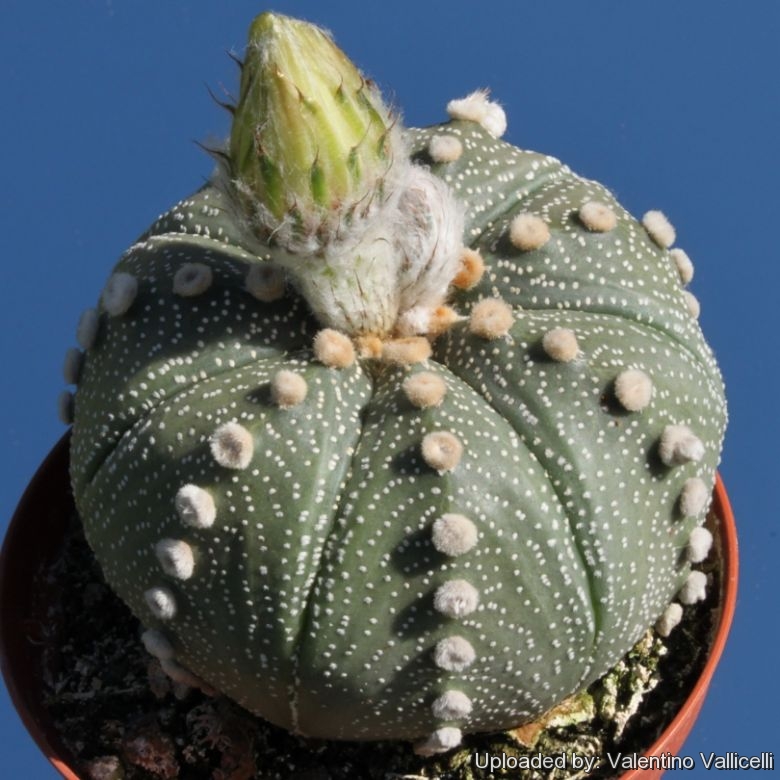
Echinocactus asterias (Astrophytum asterias) Photo by: Valentino Vallicelli
(a.k.a.Sand Dollar Cactus) It is one of the most attractive species of cactus, admired by cactus lovers.
Origin and Habitat: It was once found throughout Texas and Mexico in an area of occupancy of less than 2,000 km² at the Mexico-USA border to the east of the Sierra Madre Oriental mountain in the states of Tamaulipas (Gonzales, El Hundido, Estancion Calles, Fortin Agrero, Llera, Ejido 21. Marzo, Rancho San Antonio, South of San Carlos and south of Cd. Victoria), Nuevo Leon (Lucio Blanco) and the lower Rio Grande Valley, of Texas in the United States (Starr and Hidalgo County).
Altitude: 50-200 metres above sea-level.
Habitat: It grow on hills, hollows and along the sides of dry river beds, on gravelly alluvial loams and saline or calcareous clays in thorn shrub vegetation and grasslands in warm-temperate, subtropical steppe climate (semi-desert). Astrophytum asteriasSN|1464]]SN|1464]] is mainly found in the shade of other plants or rock in the grass up to the edge of the bushes almost completely buried underground, often covered by sand. It is very cryptic. Its colours matches that of the surrounding soil and is difficult to spot if not in flower. Associates succulents include Opuntia leptocaulisSN|10936]]SN|10936]], Mammillaria heyderiSN|20805]]SN|20805]], Thelocactus schwarziiSN|15806]]SN|15806]], Echinocereus reichenbachiiSN|7575]]SN|7575]] var. fitchii, Homalocephala texensisSN|2230]]SN|2230]], Pilosocereus palmeriSN|6732]]SN|6732]], Coryphantha macromeris var. runyoniiSN|10029]]SN|10029]] and Stenocereus pruinosusSN|7951]]SN|7951]]. Precipitation less than 500 mm per annum. Much of its original habitat has been destroyed by habitat destruction, agricultur, collecting and foraging by cottontail-rabbits in Texas and in Tamaulipas. Once fairly widely distributed in south Texas, the species is now known from only one locality near Rio Grande City. Several localities are known in Mexico, both north and south of Ciudad Victoria. The species may also have occurred in the State of Nuevo León and is hence Regionally Extinct there. The total population numbers more than 5,000 plants from known localities in both countries.
Synonyms:
See all synonyms of Astrophytum asterias
back
Accepted name in llifle Database:Astrophytum asterias (Zucc.) Lem.Cactées 50. 1868Synonymy: 18
Cultivars
(73):
back
Common Names include:
ENGLISH: Sand Dollar Cactus, Sea Urchin Cactus, Star Cactus, Star Peyote
CHINESE (中文): 星葉球
DUTCH (Nederlands): Zeeëgelcactus
FRENCH (Français): Cactus oursin
GERMAN (Deutsch): Seeigelkaktus
HUNGARIAN (Magyar): Csillagkaktusz
JAPANESE (日本語): 兜丸
LITHUANIAN (Lietuvių): Tikrasis žvaigždinas
RUSSIAN (Русский): Астрофитум звёздчатый, Астрофитум астериас
SLOVAK (Slovenčina): Astrofyt ježovkový
SPANISH (Español): Biznaga algodoncillo de estrella, Cacto estrella
SWEDISH (Svenska): Sjöstjärnekaktus, Stjärnkaktus
Description: Astrophytum asteriasSN|1464]]SN|1464]] (a.k.a. Sea-Urchin Cactus or Sand Dollar) is an extremely flat barrel cactus with unique and remarkably beautiful form and no typical covering of spines, but with tiny speckled tuft of hairs less than pinhead-sized. It produces large yellow flowers with orange throats often larger than the plant itself. The common name comes from resemblance to sea urchin without spines.
Habit: It is a solitary (unless damaged) perennial stem succulent growing deep seated just flat to the ground surface. Only in cultivation plants may have a spherical till columnar shape.
Roots: The underground body is fleshy, turnip-like, with fine diffuse roots.
Stem: Non-branched, much depressed, disc-shaped to low dome-shaped, grey-green to dull green (unless stressed), mature plants 2-7 cm tall, 5-16 cm broad, dotted with numerous minuscule tufts of bright white wool (hairy scales). These hairy scales are usually loose, sprinkled over the stem in irregular patterns, sometimes arched around the areoles or on line. Cultivated plants possess sometimes very dense and big hairy scales. The short white wool on surface, said to substitute for lack of shade from spines. There are also completely flake free pure green specimens.
Ribs: The stem is typically divided by very narrow but distinct vertical grooves into 8 broad ribs. The ribs are very low, almost flat on top, forming triangular sections with no cross-grooves. The normal rib number eight is very stable in wild specimens, independent of the age of the plant, but in cultivation selected cultivars and hybrids can have from 4 to 13 ribs.
Areoles: Round, prominent, 3-12 mm in diameters, forming a line up to the centre of each rib, felted to hairy, white, creamy, dirty-yellow till straw-coloured, then grey. Normally 3 to 10 mm apart, but sometime very close one to each other in cultivated plants.
Spines: Not any. Only seedlings show some rudimentary spines within the first weeks and months.
Flowers: Apical, diurnal, radial, 3-5 cm long, 5-7(-9) cm in diameter opening widely, yellow with orange/red throats. Ovary and tube very short, densely covered with thin, bristle-like, black tipped scales and with cobwebby wool in axils. Outer tepals short, narrow, pointed, greenish, covered with short fuzz on outer surfaces; inner tepals long, slightly spatulate, from narrow orange-red bases; upper parts clear yellow, edges entire, tips entire and slightly pointed to erose and irregular. Filaments orange at bases, yellow above, anthers and pollen yellow. Style yellowish with 10-12 yellowish-green stigma lobes.
Blooming season: In habitat the flowering period is spring and each flower lasts for one or two days only, but the plant may flower at any time during the warmer months of the year if adequate water is provided.
Fruits: Oval to round, about 1,5-2 cm long, green, pinkish or greyish-red densely covered with spines and dull-white wool, becoming dry and finally breaking off at or near base (not opening above the base).
Seeds: Black or dark brown, glossy, bowl to helmet shaped about 2 mm long, 3 mm broad.
Similar species: Astrophytum asteriasSN|1464]]SN|1464]] is sometimes confused with peyote (Lophophora williamsiiSN|1117]]SN|1117]]). Both species are spine-less, and peyote often has 8 ribs. However, peyote is bluish-green but has irregularly shaped ribs and lacks the tiny whitish scales.
Remarks: The stem is said to be suffused with chemical compounds distasteful to herbivores.
Subspecies, varieties, forms and cultivars of plants belonging to the Astrophytum asterias group
 Astrophytum asterias (Zucc.) Lem.: Non-branched, flat, dark green. Just flat to the ground surface, the plant body grows on the native habitat practically complete buried . Only in cultivation plants may have a spherical till columnar shape. Diameter 3-8(-16) cm. Height 2 to 6 cm.
Astrophytum asterias (Zucc.) Lem.: Non-branched, flat, dark green. Just flat to the ground surface, the plant body grows on the native habitat practically complete buried . Only in cultivation plants may have a spherical till columnar shape. Diameter 3-8(-16) cm. Height 2 to 6 cm. Astrophytum asterias f. aurea hort.: Mutant completely lacking chlorophyll pigment. The result is a completely yellow or yellow-orange plant.
Astrophytum asterias f. aurea hort.: Mutant completely lacking chlorophyll pigment. The result is a completely yellow or yellow-orange plant. Astrophytum asterias f. cristatum hort.: The crested form only deviate from the typical form for the stem which is fan shaped up to 30 cm (or more ) in diameter with age.
Astrophytum asterias f. cristatum hort.: The crested form only deviate from the typical form for the stem which is fan shaped up to 30 cm (or more ) in diameter with age. Astrophytum asterias var. nudum Y.Itô: (a.k.a. cv. Ruri Kabuto) This form has a very characteristic glabrous stem lacking the white tufts of loose hairy scales typical of the common Astrophytum asterias.
Astrophytum asterias var. nudum Y.Itô: (a.k.a. cv. Ruri Kabuto) This form has a very characteristic glabrous stem lacking the white tufts of loose hairy scales typical of the common Astrophytum asterias. Astrophytum asterias var. nudum f. aurea hort.: Nude mutant completely lacking chlorophyll pigment. The result is a completely yellow plant.
Astrophytum asterias var. nudum f. aurea hort.: Nude mutant completely lacking chlorophyll pigment. The result is a completely yellow plant. Astrophytum asterias var. nudum f. cristata hort.: Crested nude form.
Astrophytum asterias var. nudum f. cristata hort.: Crested nude form. Astrophytum asterias var. nudum f. rubra hort.: has nude ribs of a bright orange-red colour due to the absence (or reduced production) of chlorophyll pigments.
Astrophytum asterias var. nudum f. rubra hort.: has nude ribs of a bright orange-red colour due to the absence (or reduced production) of chlorophyll pigments. Astrophytum asterias f. proliferum hort.: This form varies from the typical Astrophytum asterias for the tendency to branch forming small side pups from the areole.
Astrophytum asterias f. proliferum hort.: This form varies from the typical Astrophytum asterias for the tendency to branch forming small side pups from the areole. Astrophytum asterias var. roseiflorum Frič: Selected form with pink coloured flowers. However a very few pink flowered specimens will appear time by time among normal yellow flowered plants.
Astrophytum asterias var. roseiflorum Frič: Selected form with pink coloured flowers. However a very few pink flowered specimens will appear time by time among normal yellow flowered plants. Astrophytum asterias cv. Akabana: (Akabana Kabuto) Its flowers are red, which is very uncharacteristic of this genus. Petals are shaded in dark pinkish-red, orange-red or purple wine-red with usually even darker flower edges.
Astrophytum asterias cv. Akabana: (Akabana Kabuto) Its flowers are red, which is very uncharacteristic of this genus. Petals are shaded in dark pinkish-red, orange-red or purple wine-red with usually even darker flower edges. Astrophytum asterias cv. Alpus: the of rib tips (bearing the line of areoles) are more or less deeply seated within the plants body, while the suture line between the ribs is turned outward and more or less expanded creating odd and unique shapes.
Astrophytum asterias cv. Alpus: the of rib tips (bearing the line of areoles) are more or less deeply seated within the plants body, while the suture line between the ribs is turned outward and more or less expanded creating odd and unique shapes.- Astrophytum asterias cv. Ekubo Kabuto
 Astrophytum asterias cv. Elephant Skin: has a bumpy elephant-like skin.
Astrophytum asterias cv. Elephant Skin: has a bumpy elephant-like skin.  Astrophytum asterias cv. Feather Flower: has colourful fringed petals.
Astrophytum asterias cv. Feather Flower: has colourful fringed petals.  Astrophytum asterias cv. Fukuryiu: Plant with dditional ribs. This plant will develop protuberances (like beginnings of ribs) or small extra ribs (more or less prominent ). Usually these additional ribs will not reach the plant apex.
Astrophytum asterias cv. Fukuryiu: Plant with dditional ribs. This plant will develop protuberances (like beginnings of ribs) or small extra ribs (more or less prominent ). Usually these additional ribs will not reach the plant apex.- Astrophytum asterias cv. Gelbe Bluete
 Astrophytum asterias cv. Godzilla: Has reptile-like skin.
Astrophytum asterias cv. Godzilla: Has reptile-like skin. Astrophytum asterias cv. Gokuu-kabuto
Astrophytum asterias cv. Gokuu-kabuto- Astrophytum asterias cv. Golden kabuto
 Astrophytum asterias cv. Goryo Kabuto (Five Ribs): 5 ribbed form available with different pattern of the spots.
Astrophytum asterias cv. Goryo Kabuto (Five Ribs): 5 ribbed form available with different pattern of the spots. Astrophytum asterias cv. Goryo Kabuto (Five Ribs) + Ruri: has nude stems with only 5 ribs.
Astrophytum asterias cv. Goryo Kabuto (Five Ribs) + Ruri: has nude stems with only 5 ribs. Astrophytum asterias cv. Goryo Kabuto (Five Ribs) + Ruri + Fukuryiu + Ooibo
Astrophytum asterias cv. Goryo Kabuto (Five Ribs) + Ruri + Fukuryiu + Ooibo Astrophytum asterias cv. Hakuun: This cultivar varies from the typical A. asterias for the white flecks that condense, forming characteristic cloud-like patches.
Astrophytum asterias cv. Hakuun: This cultivar varies from the typical A. asterias for the white flecks that condense, forming characteristic cloud-like patches.- Astrophytum asterias cv. Hakuun forma prolifera: Plant distingushed for the white flecks that condense, forming characteristic cloud-like patches and for the tendency to branch forming small side pups from the areole.
- Astrophytum asterias cv. Hanaizumi
 Astrophytum asterias cv. Hanazono: Some additional woolly areoles are produced on the ribs surface. Flowers buds develop from the median line between two ribs and usually they are not produced by areoles.
Astrophytum asterias cv. Hanazono: Some additional woolly areoles are produced on the ribs surface. Flowers buds develop from the median line between two ribs and usually they are not produced by areoles. Astrophytum asterias cv. Hanazono Star Type
Astrophytum asterias cv. Hanazono Star Type- Astrophytum asterias cv. Ibosaki Kabuto
 Astrophytum asterias cv. Ikaryoko: Monstrous form.
Astrophytum asterias cv. Ikaryoko: Monstrous form.- Astrophytum asterias cv. Kigan Kabuto
 Astrophytum asterias cv. Kikko: (Kikko Kabuto) It has raised tubercles along the ribs edges, in fact its areoles stick out with large notches between them, giving them a bumpy look.
Astrophytum asterias cv. Kikko: (Kikko Kabuto) It has raised tubercles along the ribs edges, in fact its areoles stick out with large notches between them, giving them a bumpy look. Astrophytum asterias cv. Kikko Lizard Skin: has broad raised tubercles with a lizard Skin and the plant appears decorated with a geometrical design which is raised above the surface, giving it a bumpy look.
Astrophytum asterias cv. Kikko Lizard Skin: has broad raised tubercles with a lizard Skin and the plant appears decorated with a geometrical design which is raised above the surface, giving it a bumpy look.  Astrophytum asterias cv. Kikko Nudum: This is the nude form of "Kikko" with raised tubercles along the ribs edges, it resembles some chinned cacti particularly some Gymocalyciums.
Astrophytum asterias cv. Kikko Nudum: This is the nude form of "Kikko" with raised tubercles along the ribs edges, it resembles some chinned cacti particularly some Gymocalyciums. Astrophytum asterias cv. Kikko Nudum f. aurea: This is the albinos form of "Kikko" (Mutant completely lacking chlorophyll pigment) The result is a completely cream-white, yellow or reddish plant.
Astrophytum asterias cv. Kikko Nudum f. aurea: This is the albinos form of "Kikko" (Mutant completely lacking chlorophyll pigment) The result is a completely cream-white, yellow or reddish plant. Astrophytum asterias cv. Kikko Nudum f. cristata: crested form.
Astrophytum asterias cv. Kikko Nudum f. cristata: crested form. Astrophytum asterias cv. Kikko Nudum violet: This is the violet schizochromic form form of "Kikko". The result is a magenta-violet plant.
Astrophytum asterias cv. Kikko Nudum violet: This is the violet schizochromic form form of "Kikko". The result is a magenta-violet plant.- Astrophytum asterias cv. Kiku Kabuto
- Astrophytum asterias cv. Kofuki Kabuto
- Astrophytum asterias cv. Koo-yo
 Astrophytum asterias cv. Mamma Kikko: has ribs completely divides in tubercles that resemble women breasts. When viewed from above the plants resemble a tortoise-shell.
Astrophytum asterias cv. Mamma Kikko: has ribs completely divides in tubercles that resemble women breasts. When viewed from above the plants resemble a tortoise-shell.- Astrophytum asterias cv. Mirakuru Kabuto
- Astrophytum asterias cv. Mottles
 Astrophytum asterias cv. muscle: has green ribs with large creamy white areoles and for the abnormal tendency to branch forming small side pups. Ribs usually 8 with raised tubercles giving them a bumpy look.
Astrophytum asterias cv. muscle: has green ribs with large creamy white areoles and for the abnormal tendency to branch forming small side pups. Ribs usually 8 with raised tubercles giving them a bumpy look. Astrophytum asterias cv. muscle cristatum: crested form with green ribs with large creamy white areoles.
Astrophytum asterias cv. muscle cristatum: crested form with green ribs with large creamy white areoles.- Astrophytum asterias cv. Musha Kabuto
 Astrophytum asterias cv. Nisiki (orange): has sectors, patches or stripes with distinct shades of orange-red.
Astrophytum asterias cv. Nisiki (orange): has sectors, patches or stripes with distinct shades of orange-red. Astrophytum asterias cv. Nisiki (yellow): has sectors, patches or stripes with distinct shades of yellow.
Astrophytum asterias cv. Nisiki (yellow): has sectors, patches or stripes with distinct shades of yellow.- Astrophytum asterias cv. Nohakuten Kabuto: Heavily flecked form.
- Astrophytum asterias cv. Ohkan Kabuto
 Astrophytum asterias cv. Ooibo + Ruri (nudum) Kabuto: Plant with large woolly areoles (typical of cv. Ooibo) and with green nude stem ( Typical of cv. Rury Kabuto)
Astrophytum asterias cv. Ooibo + Ruri (nudum) Kabuto: Plant with large woolly areoles (typical of cv. Ooibo) and with green nude stem ( Typical of cv. Rury Kabuto) Astrophytum asterias cv. Ooibo Kabuto: Japanese selected strain with big wooly areoles, the colour of the wool also varies from pure white, to pastel, yellowish, orangish or brownish depending on the clone.
Astrophytum asterias cv. Ooibo Kabuto: Japanese selected strain with big wooly areoles, the colour of the wool also varies from pure white, to pastel, yellowish, orangish or brownish depending on the clone.- Astrophytum asterias cv. Rasen Kabuto
 Astrophytum asterias cv. Rensei: It is a nice selection with densely packaged areoles (usually orangish) on the rib edges. The areoles tend to merge, forming an almost continuous line.
Astrophytum asterias cv. Rensei: It is a nice selection with densely packaged areoles (usually orangish) on the rib edges. The areoles tend to merge, forming an almost continuous line. Astrophytum asterias cv. Ruri Kabuto Akabana: has smooth green stem of cv. Ruri Kabuto (Astrophytum asterias var. nudum) and bright red flowers of cv. Akabana.
Astrophytum asterias cv. Ruri Kabuto Akabana: has smooth green stem of cv. Ruri Kabuto (Astrophytum asterias var. nudum) and bright red flowers of cv. Akabana. Astrophytum asterias cv. Ruri Kabuto Nisiki (Orange-Red): a.k.a.: forma nuda variegata (Orange-Red Type)
Astrophytum asterias cv. Ruri Kabuto Nisiki (Orange-Red): a.k.a.: forma nuda variegata (Orange-Red Type) Astrophytum asterias cv. Ruri Kabuto Nisiki (Yellow): a.k.a.: forma nuda variegata (Yellow Type)
Astrophytum asterias cv. Ruri Kabuto Nisiki (Yellow): a.k.a.: forma nuda variegata (Yellow Type)- Astrophytum asterias cv. Sakata Kabuto
 Astrophytum asterias cv. Showa: (a.k.a. Shinshowa Kabuto) has yellow flowers with very fine petals, cut into shreds.
Astrophytum asterias cv. Showa: (a.k.a. Shinshowa Kabuto) has yellow flowers with very fine petals, cut into shreds. Astrophytum asterias cv. Showa Red: (a.k.a. Red Shinshowa Kabuto) has pink-red or orange-red flowers with very fine petals, cut into shreds.
Astrophytum asterias cv. Showa Red: (a.k.a. Red Shinshowa Kabuto) has pink-red or orange-red flowers with very fine petals, cut into shreds.  Astrophytum asterias cv. Star Type: This cultivar only varies from the typical A. asterias for the star shaped stem instead of rounded .
Astrophytum asterias cv. Star Type: This cultivar only varies from the typical A. asterias for the star shaped stem instead of rounded . Astrophytum asterias cv. Super Hanazono: has the inimitable furry additional areoles of cv. Hanazono with the large mosaic of extensive white spots of cv. Superkabuto. The result is an intensely white and furry plant.
Astrophytum asterias cv. Super Hanazono: has the inimitable furry additional areoles of cv. Hanazono with the large mosaic of extensive white spots of cv. Superkabuto. The result is an intensely white and furry plant. Astrophytum asterias cv. Superkabuto: Distinguished from the normal A. asterias by the epidermis, that does not have simple dots, but a mosaic of extensive white spots that make the plant look intensely maculate.
Astrophytum asterias cv. Superkabuto: Distinguished from the normal A. asterias by the epidermis, that does not have simple dots, but a mosaic of extensive white spots that make the plant look intensely maculate. Astrophytum asterias cv. Superkabuto + Ooibo: has very large characteristic and woolly areoles, the colour of the wool also varies from pure white, to pastel, yellowish, orangish or brownish depending on the clone.
Astrophytum asterias cv. Superkabuto + Ooibo: has very large characteristic and woolly areoles, the colour of the wool also varies from pure white, to pastel, yellowish, orangish or brownish depending on the clone.  Astrophytum asterias cv. Superkabuto + Rensei (Line Areoles): has densely packaged areoles (often orangish) on the rib edges. The areoles tend to merge, forming an almost continuous line.
Astrophytum asterias cv. Superkabuto + Rensei (Line Areoles): has densely packaged areoles (often orangish) on the rib edges. The areoles tend to merge, forming an almost continuous line.  Astrophytum asterias cv. Superkabuto f. cristata: The crested form of "SUPERKABUTO", only deviate from the typical form for the stem which is fan shaped up to 30 cm (or more ) in diameter with age.
Astrophytum asterias cv. Superkabuto f. cristata: The crested form of "SUPERKABUTO", only deviate from the typical form for the stem which is fan shaped up to 30 cm (or more ) in diameter with age. Astrophytum asterias cv. Superkabuto f. monstruosa: has slender, triangular ariocarpus-like tubercles around the woolly crown of a spherical flattened stem covered by a creamy-white felt.
Astrophytum asterias cv. Superkabuto f. monstruosa: has slender, triangular ariocarpus-like tubercles around the woolly crown of a spherical flattened stem covered by a creamy-white felt. Astrophytum asterias cv. Superkabuto f. prolifera: distinguishable for the tendency to branch forming small side pups from the areole..
Astrophytum asterias cv. Superkabuto f. prolifera: distinguishable for the tendency to branch forming small side pups from the areole.. Astrophytum asterias cv. Superkabuto f. prolifera cristata: this is a peculiar crested form with an abnormal tendency to branch forming small side pups from the areole.
Astrophytum asterias cv. Superkabuto f. prolifera cristata: this is a peculiar crested form with an abnormal tendency to branch forming small side pups from the areole.  Astrophytum asterias cv. Superkabuto Five Ribs: The form with only five ribs, is particularly rare because many of the 5 ribbed seedlings that occasionally appear will usually develop additional ribs in a few years as they age.
Astrophytum asterias cv. Superkabuto Five Ribs: The form with only five ribs, is particularly rare because many of the 5 ribbed seedlings that occasionally appear will usually develop additional ribs in a few years as they age. Astrophytum asterias cv. Superkabuto Snow Type: It differ for the dense white covering of dots that almost conceal the epidermis, this particular form is also called "Snow White", or “White Form” .
Astrophytum asterias cv. Superkabuto Snow Type: It differ for the dense white covering of dots that almost conceal the epidermis, this particular form is also called "Snow White", or “White Form” . Astrophytum asterias cv. Superkabuto Snow Type f. cristata: crested form with stems completely concealed by tufts of bright white hairy scales.
Astrophytum asterias cv. Superkabuto Snow Type f. cristata: crested form with stems completely concealed by tufts of bright white hairy scales. Astrophytum asterias cv. Superkabuto Snow Type f. monstruosa: produces odd bumped shapes with branches completely concealed by tufts of bright white hairy scales, and it is possible to find clones with different degrees of monstrosity.
Astrophytum asterias cv. Superkabuto Snow Type f. monstruosa: produces odd bumped shapes with branches completely concealed by tufts of bright white hairy scales, and it is possible to find clones with different degrees of monstrosity. Astrophytum asterias cv. Superkabuto Star Type: Typical "Superkabuto" with extensive white spots, but with star shaped stem instead of rounded. .
Astrophytum asterias cv. Superkabuto Star Type: Typical "Superkabuto" with extensive white spots, but with star shaped stem instead of rounded. . Astrophytum asterias cv. Superkabuto Star Type + Snow type
Astrophytum asterias cv. Superkabuto Star Type + Snow type Astrophytum asterias cv. Superkabuto Star Type + V Type: This is a very nice and distinguishing plant that combine the star shaped form with the V pattern of the "V type" form.
Astrophytum asterias cv. Superkabuto Star Type + V Type: This is a very nice and distinguishing plant that combine the star shaped form with the V pattern of the "V type" form. Astrophytum asterias cv. Superkabuto Sutadorimu: (Star Dream)
Astrophytum asterias cv. Superkabuto Sutadorimu: (Star Dream) Astrophytum asterias cv. Superkabuto V type: a.k.a. "V-type", “Fly's wings type” or “Tiger”. It differs for the diverse pattern that form distinct v-shaped lines resembling the shape of fly's wings.
Astrophytum asterias cv. Superkabuto V type: a.k.a. "V-type", “Fly's wings type” or “Tiger”. It differs for the diverse pattern that form distinct v-shaped lines resembling the shape of fly's wings. Astrophytum asterias cv. Superkabuto V type f. cristatum
Astrophytum asterias cv. Superkabuto V type f. cristatum Astrophytum asterias cv. Superkabuto Yellow Dots Type
Astrophytum asterias cv. Superkabuto Yellow Dots Type- Astrophytum asterias cv. Taryo Kabuto
 Astrophytum asterias cv. Thirteen ribs: The normal rib number (eight) is very stable in wild specimens. The form with thirteen ribs is quite exceptional.
Astrophytum asterias cv. Thirteen ribs: The normal rib number (eight) is very stable in wild specimens. The form with thirteen ribs is quite exceptional. - Astrophytum asterias cv. Wakareryu
Notes: The name "Peyote" used by the natives comes presumably by the external similarity to Lophophora williamsii, however there is no closer botanic relationship. Till now, there is no found of hallucinogenic in the plants despite multiple contrary assertions.
Bibliography: Major references and further lectures
1) Edward Anderson “The Cactus family” Timber Press, Incorporated, 2001
2) Tony Sato "Astrophytum Handbook VOL.1 ASTERIAS FAMILY" Japan Cactus Planning Co Press 1973
3) James Cullen, Sabina G. Knees, H. Suzanne Cubey "The European Garden Flora Flowering Plants: A Manual for the Identification of Plants Cultivated in Europe, Both Out-of-Doors and Under Glass" Cambridge University Press, 11/Aug/2011
4) David R Hunt; Nigel P Taylor; Graham Charles; International Cactaceae Systematics Group. "The New Cactus Lexicon" dh books, 2006
5) N. L. Britton, J. N. Rose: “The Cactaceae. Descriptions and Illustrations of Plants of the Cactus Family.” Volume III, The Carnegie Institution of Washington, Washington 1922
6) Brian Loflin, Shirley Loflin “Texas Cacti: A Field Guide” Texas A&M University Press, 26/Oct/2009
7) Albert Michael Powell, James F. Weedin “Cacti of the Trans-Pecos and Adjacent Areas” Texas Tech University Press, 2004
8) Del Weniger “Cacti of Texas and Neighboring States: A Field Guide” University of Texas Press, 1984
9) Alfred Richardson “Plants of Deep South Texas: A Field Guide to the Woody and Flowering Species” Texas A&M University Press, 2010
10) Jackie M. Poole, William R. Carr, Dana M. Price “Rare Plants of Texas: A Field Guide” Texas A&M University Press, 2007
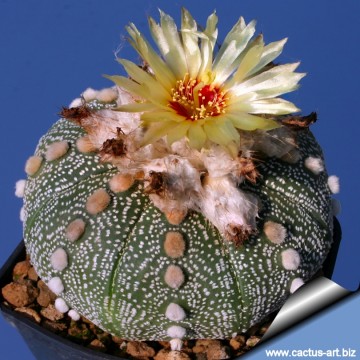 Echinocactus asterias (Astrophytum asterias) Photo by: Cactus Art
Echinocactus asterias (Astrophytum asterias) Photo by: Cactus Art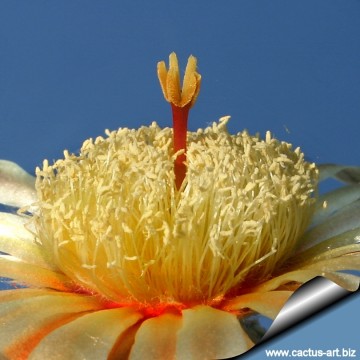 Echinocactus asterias (Astrophytum asterias) Photo by: Cactus Art
Echinocactus asterias (Astrophytum asterias) Photo by: Cactus Art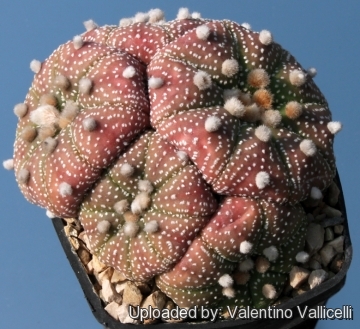 Echinocactus asterias (Astrophytum asterias) Photo by: Valentino Vallicelli
Echinocactus asterias (Astrophytum asterias) Photo by: Valentino Vallicelli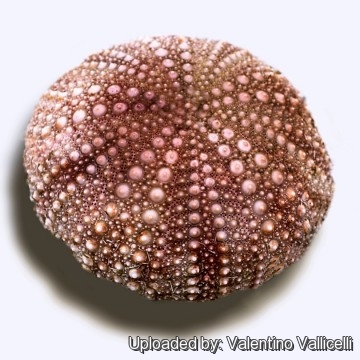 ''Asterias'' is the name of a genus of starfish (but this plant looks like the sea urchin shell) (Astrophytum asterias) Photo by: Valentino Vallicelli
''Asterias'' is the name of a genus of starfish (but this plant looks like the sea urchin shell) (Astrophytum asterias) Photo by: Valentino Vallicelli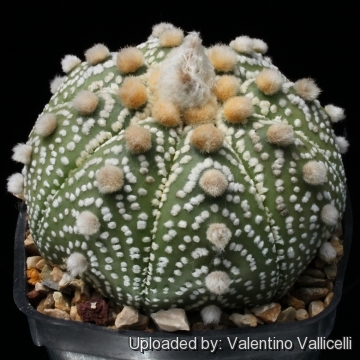 Echinocactus asterias (Astrophytum asterias) Photo by: Valentino Vallicelli
Echinocactus asterias (Astrophytum asterias) Photo by: Valentino Vallicelli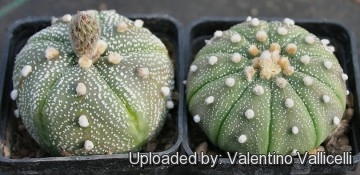 Generally it has 8 ribs, few or more ribs are unusual. (Astrophytum asterias) Photo by: Valentino Vallicelli
Generally it has 8 ribs, few or more ribs are unusual. (Astrophytum asterias) Photo by: Valentino Vallicelli Echinocactus asterias (Astrophytum asterias) Photo by: Cactus Art
Echinocactus asterias (Astrophytum asterias) Photo by: Cactus Art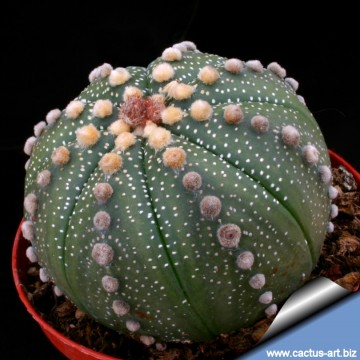 Echinocactus asterias (Astrophytum asterias) Photo by: Cactus Art
Echinocactus asterias (Astrophytum asterias) Photo by: Cactus ArtCultivation and Propagation: Astrophytum asteriasSN|1464]]SN|1464]] is a summer grower species relatively easy to grow. It is sometime seen as a grafted plant but grows very well on its own roots too. It is not too difficult in a greenhouse, although grows quite slowly.
Soil: Use mineral well permeable substratum with little organic matter (peat, humus), plants may become too elongated if compost is too rich.
Repotting: Re-pot every 2 years. Use pot with good drainage.
Fertilization: It grows much faster with a low nitrogen content fertilizer in spring and summer. Potassium helps maintaining the plants compact and healthy.
Watering: Requires careful watering to keep plant compact. Water sparingly from March till October, the thin, fibrous roots suffer if there is humidity, therefore the plant should be watered only when the surrounding terrain is dry. Keep dry as soon as the temperature starts dropping in October and keep it perfectly dry in winter at temperatures from 5 to 15 degrees centigrade.
Hardiness: They need to be kept in a cool place during winter rest and are somewhat resistant to frost if kept on the dry side prior to, and during, cold weather (due to the altitude they are hardy to -5 C ° C, or less for short periods).It tends to rot in winter during the resting phase, if kept wet. In the rest period no high atmospheric humidity!!
Sun Exposure: Light shade to full sun, its colour tends to richer and darker when grown in light shade.
Uses: It is an excellent plant for container growing. It always looks good and stays small.
Pests & diseases: It may be attractive to a variety of insects, but plants in good condition should be nearly pest-free, particularly if they are grown in a mineral potting-mix, with good exposure and ventilation. Nonetheless, there are several pests to watch for:
- Red spiders: Red spiders may be effectively rubbed up by watering the infested plants from above.
- Mealy bugs: Mealy bugs occasionally develop aerial into the new growth among the wool with disfiguring results, but the worst types develop underground on the roots and are invisible except by their effects.
- Scales: Scales are rarely a problem.
- Rot: Rot is only a minor problem with cacti if the plants are watered and “aired” correctly. If they are not, fungicides won't help all that much. To prevent rottenness it is also advisable to surround its root neck by very rough sand or grit, this help a fast water drainage.
Propagation: By seeds, remembering that seedlings dislike strong light and dry conditions and need to be repotted frequently. Eventually, as they become mature, they attain a maximum size of 8-10 cm (20) cm. However, old plants become senile and have a tendency to succumb to disease and a weak root system. At this stage, as is well known, they die suddenly. So, after they reach 10 cm in diameter grow them slowly, and adopt a new repotting period, using intervals of every 2-3 years. Additionally grow them under drier conditions or with stronger sunlight. But plants are often grafted to accelerate growth as they would generally take at least a five years to reach maturity on their own, but the grafted plants are typical rather tall growing, compared with plants on their own roots that are usually more flat to the ground.
Remarks: This quite variable plant has been widely grown for years and is now available in several cultivated variety and several breeds do exist. The famous “Superkabuto” is only one of these and though maybe the most beautiful, but a lot of other forms are represented in many collections.
Your Photos
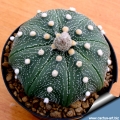
by Cactus Art

by Valentino Vallicelli

by Cactus Art

by Valentino Vallicelli
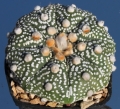
by Valentino Vallicelli
























